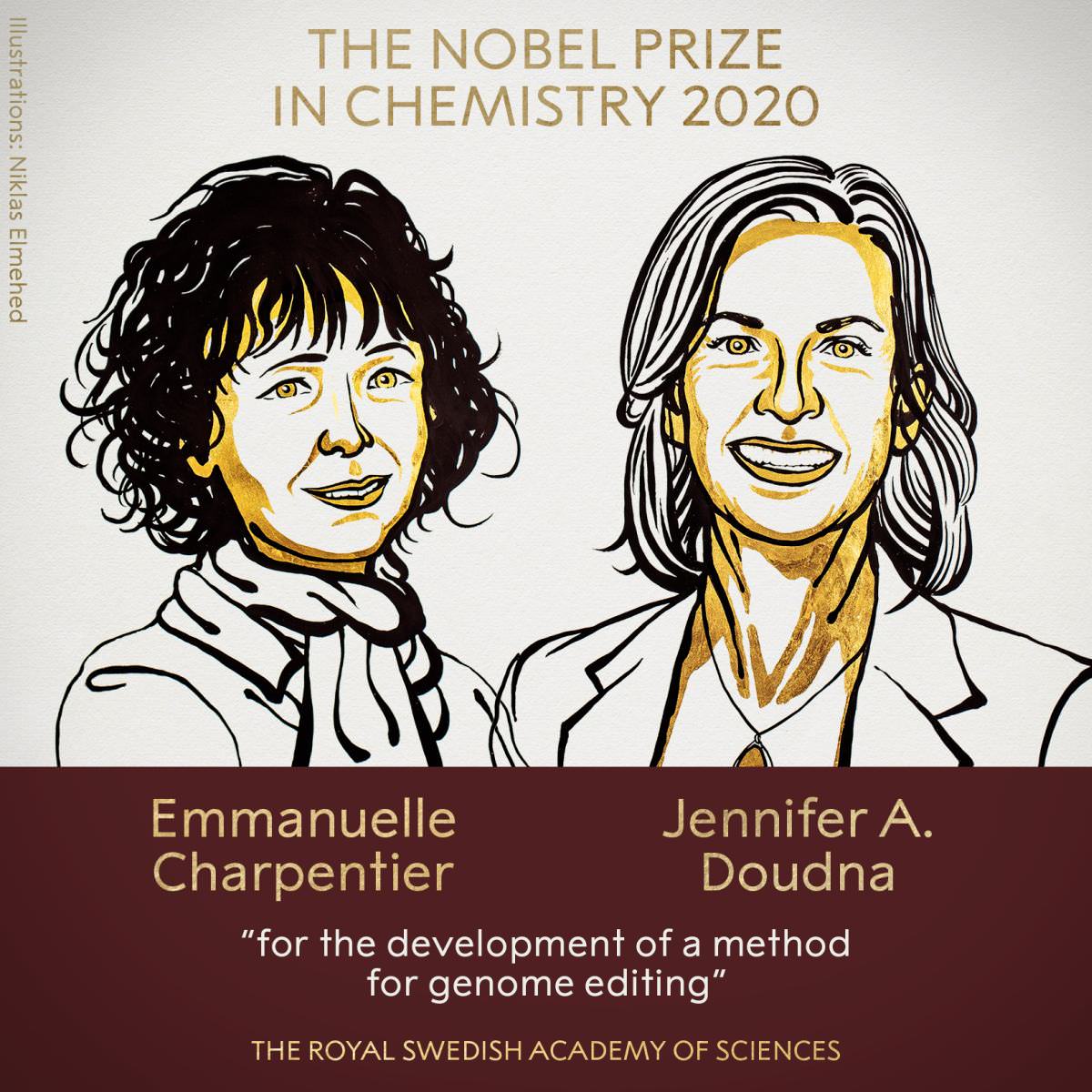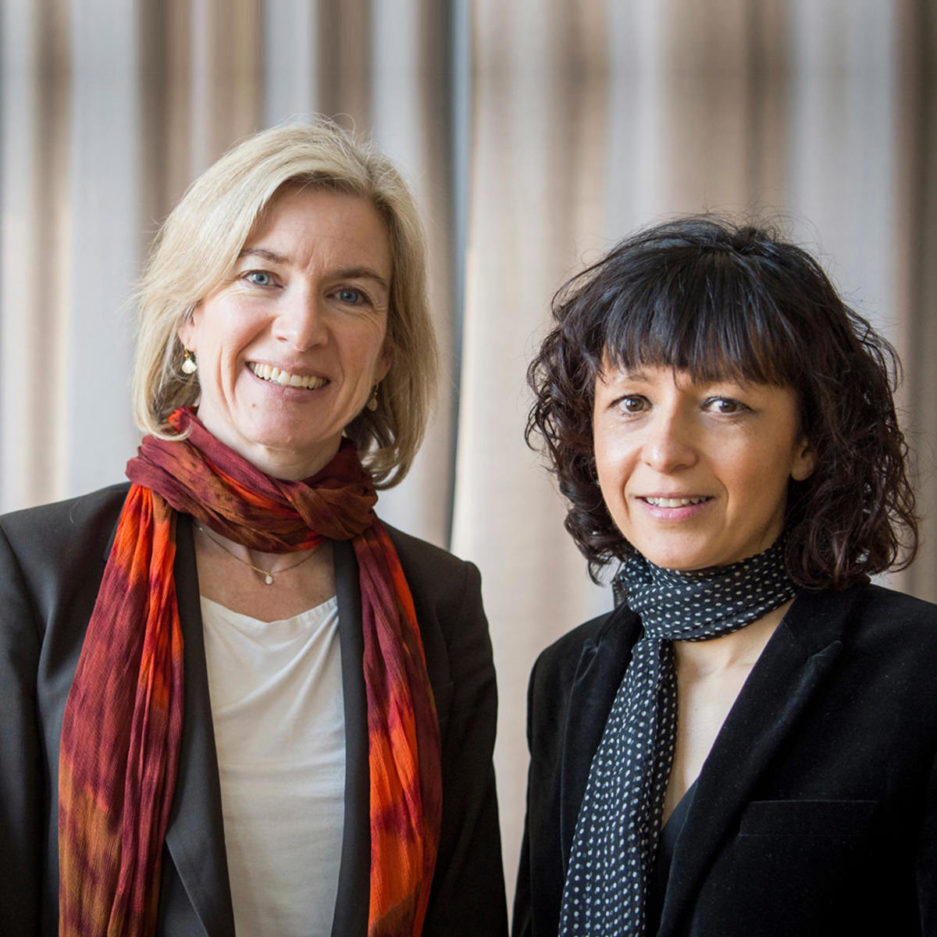It’s something that 185 men and only five women have done in the past. French microbiologist Emmanuelle Charpentier and American biochemist Jennifer Doudna are the first two women scientists to share the Nobel Prize for Chemistry, taking the tally of women who have won the coveted award to seven. This is in recognition of their research on a genome editing tool called CRISPR-Cas9 or “genetic scissors” which can be used by researchers to change the DNA of animals, plants, and micro-organisms. Both will equally share the prize money of 10 million Swedish Krona (USD 1.1 million).
The two scientists made the discovery of these “genetic scissors” in the year 2012 which has led to advancement in the field of new cancer therapies, treatment of diseases and takes us closer to the dream of curing hereditary diseases. In the plant kingdom, it will help in developing crops that are resistant to moulds, pests, and drought.
Doudna said:
“I’m proud of my gender. I think it’s great, especially for younger women, to see this and to see that women’s work can be recognized as much as men’s.”
Charpentier said:
“I think it’s very important for women to see a clear path. I think the fact that Jennifer Doudna and I were awarded this prize today can provide a very strong message for young girls.”
She further added that this will provide a positive message to the young girls who want to follow the path of science and to show them that women in science can also have an impact through the research they are performing.

About the two scientists
Emmanuelle Marie Charpentier was born on 11th December 1968 in Juvisy-sur-Orge, France. She studied biochemistry, microbiology, and genetics (B. Sc., M.Sc., D. Phill) at Pierre and Marie Curie University which today is known by the name of Faculty of Science of Sorbonne University at Paris. She did her Ph. D. training from the Institut Pasteur and was awarded a research doctorate for her Ph. D. project which investigated molecular mechanisms involved in antibiotic resistance.
She worked across continents in various roles starting from New York to Vienna to Sweden and Germany winning numerous international awards, prizes, and acknowledgments. Since 2015, Charpentier has been the Director at the Max Planck Institute for Infection Biology in Berlin and an honorary professor at Humboldt University in Berlin since 2016. In 2018, she founded an independent research institute, the Max Planck Unit for the Science of Pathogens of which she is the Founding and Acting Director.
Jennifer Anne Doudna was born on 19th February 1964 in Washington and was raised in Hawaii. She graduated in biochemistry from Pomona College in California in 1985 and earned a Ph.D. from Harvard Medical School in 1989 in Biological Chemistry and Molecular Pharmacology.
Jennifer, like Charpentier, received several awards and acclamations throughout her career. She works at the Department of Chemistry and the Department of Molecular and Cell Biology at the University of California, Berkeley as the Li Ka Shing Chancellor’s Chair Professor. She has been an investigator with the Howard Hughes Medical Institute since 1997.
In 2015, Time magazine designated Charpentier one of the 100 most influential people in the world (together with Jennifer Doudna). In 2015, together with Emmanuelle Charpentier, she received the Breakthrough Prize in Life Sciences for her contributions to CRISPR/Cas9 genome editing technology.
The collaboration
Charpentier and Doudna combined forces in March 2011 after they met at a scientific conference in Puerto Rico and recognized that they had complementary strengths to the study of CRISPER-Cas. Earlier in the year, Charpentier published her first paper on CRISPER. She, for the first time, had found a molecule, tracrRNA, in the bacteria Streptococcus pyogenes and discovered that this molecule was part of an ancient immune system, CRISPR/Cas that could render viruses inactive by severing their DNA. Doudna too had been studying RNAs involved in the CRISPER system for several years.
Both collaborated in Doudner’s lab in California and recreated the bacteria Streptococcus pyogenes’s genetic scissors in a test tube and simplified its molecular components. They discovered the tool that can be used to make incisions in the genetic material and change the code of life.
They published their paper in Science in August 2012, in which they showed that whenever CRISPER-Cas9 was used: the bacterial enzyme Cas9 could cut purified DNA in a dish or a test tube, this Cas9 could be coupled with custom-designed molecules called CRISPER which would lead the Cas9 to the desired size on the DNA where a mutation has happened and create a change in the DNA.
Importance of CRISPER-Cas9
The paper assumed epic proportions as it led to further use and research of the technique across the globe by genome researchers and bio-technologists. Over the years, scientists have built their research on the laureates’ work and got CRISPER to edit the DNA in human cells growing in a dish. The companies CRISPR Therapeutics and Vertex have launched clinical trials using CRISPR to cure sickle cell disease and beta-thalassemia. Also, Editas Medicine is using it to find a cure for a form of congenital blindness. There are several other studies underway to find a cure to diseases as diverse as type 1 diabetes and hemophilia.
The technique can be used not only in adults and children but also in embryos and fetuses in an IVF and can be used to eliminate the disease. This “genome editing” can also be used for altering DNA which is not associated with disease and can even lead to the creation of “designer babies”. Doudna had earlier led efforts to get experts to join hands and prevent the use of this technology for such ends and said she supported it to be used in the area of disease cures.
Chinese scientist He Jiankui announced in November 2018 that he had created the world’s first “CRISPR babies,” twin girls whose genomes had been edited when they were IVF embryos. He had to face condemnation for his work from the scientific community for flouting ethical guidelines for embryo editing. In 2019, he was sentenced to 3 years and was convicted of violating a government ban on carrying out experiments on human embryos (he was trying to give them protection from HIV).
The ethical and legal considerations in the use of the technique can be profound but it can be a boon for patients with genetic disorders and for diseases that are caused due to gene mutation. A report from the U.S. National Academy of Sciences concluded that there are no ethical or scientific reasons to bar germline editing for therapeutic purposes, but not for “enhancement”
The dispute for the patent
There has been a controversy over CRISPER insofar as to whom the patents on the discovery belong.
In 2012, the University of California Berkeley (where Doudna and Charpentier collaborated) filed for patents for use of CRISPR/Cas9 for gene editing process with the United States Patent and Trademark Office.
In 2013, molecular biologist Feng Zhang from the Broad Institute in Boston, with his colleagues was able to edit genes using CRISPR inside the actual mouse and human cells and filed for patents. They were granted patents by the United States Patent and Trademark Office in 2014.
When that happened, the University of California Berkeley claimed that the patents “interfered” with the patent for which they had applied. In February 2017, the Patent Office ruled that Broad Institute’s patents were different from the ones applied for by the University of California, so no interference had occurred. The Patent Office issued a notice to the University of California Berkeley saying “UC, we are going to give you this patent that you applied for on the basic use of CRISPR in all kinds of cells.’
For now, as is apparent the University of California and Broad Institute will both needed to be compensated for any application for using the CRISPR technology in humans.
It is said Charpentier and Doudna made the first scientific discovery and deserve the Nobel prize but without Zhang’s work, CRISPER would have only remained a nice concept without its varied practical uses. Without Zhang’s work, it would have taken a decade for Charpentier and Doudna’s work to be used in the practical world. Since the Nobel can be awarded to a maximum of three people, Zhang could have been one of them.
Nobel Prize was instituted by Alfred Nobel, a Swedish chemist, engineer, and industrialist known for the invention of dynamite in his will in 1895, a year before he died. Nobel Prizes were first awarded in 1901. Nobel Prizes are awarded in the fields of Physics, Chemistry, Physiology or Medicine, Literature, and Peace. In 1968, a sixth prize was announced for Economic Sciences; however, it is not considered a Nobel Prize but a Nobel Memorial Prize.
